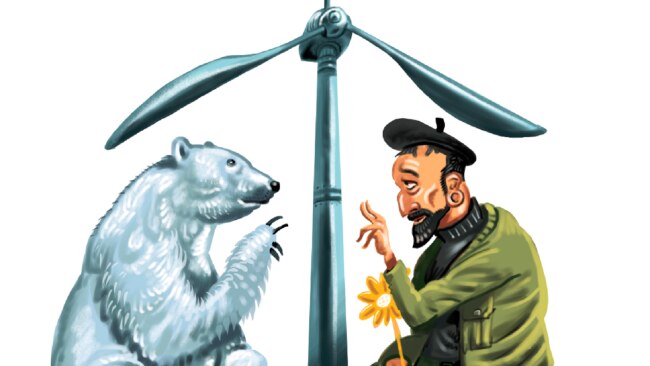WAIL OF JERICHO COMES TUMBLING DOWN
Outside of standard religious texts, there is no place on earth more clogged with fantasy, fable and folklore than a climate activist’s mind.

Outside of standard religious texts, there is no place on earth more clogged with fantasy, fable and folklore than a climate activist’s mind.
You name it and the climate crowd are into it, from starving polar bears and deadly coal to sinking Pacific islands and friendly wind turbines.
It doesn’t matter how often evidence emerges that islands remain safely above the water line, the average polar bear has a sumo wrestler’s body mass index, coal-fired electricity rescues millions of Indians and Chinese from poverty and your nice wind turbine just cut a California condor in half.
Articles of faith cannot be displaced by mere facts. Gaia said it. They believe it. That settles it.
But lately, following nearly a decade of worshipful observance, one cherished myth of the climate church has finally been retired. This is the myth of Australia being the worst per capita carbon dioxide emitter on earth.
You may have heard that line from any number of activist journalists, leftist politicians and your wife’s unemployable nephew, the one who uses glue for entirely non-adhesive purposes and doesn’t buy his mushrooms from shops.

It’s a fantastically deceitful myth on so many levels, originally devised as a way of concealing Australia’s tiny overall contribution to alleged global warming gases.
The motivation here is obvious. After all, there’s no way any sane person would be convinced by our weeny 1.3 per cent of the world’s human-generated carbon dioxide total to pursue industry-crippling anti-carbon measures. Our emissions are already so insignificant that reducing them further would make no difference at all.
But being the planet’s worst per-capita emitter sounds so much bigger and spookier, although it makes absolutely no sense even from an environmentalist perspective.
As I wrote in 2011: “If you were the environment, and if you were getting awfully bashed up by carbon emissions, would you worry about whether 1.4 per cent of that scary hurty carbon came from a miniscule fraction of China or the whole of Australia?”
Yet still the great myth of our per-capita criminality was endlessly repeated. Here’s a brief list of offenders:
“Australia is the biggest per capita emitter in the world.” – Fairfax’s Kenneth Davidson in 2008.
“Australia, as the highest per capita emitter in the world …” – Davidson again, in 2011.
“On bases of per capita emissions, there we are proudly right up the top, world champions and not by a little bit.” – Professor Ross Garnaut, former climate change advisor for the Australian government, in the 2011 update to his Climate Change Review.
“On a per capita basis, however, we zoom to the top …” – ABC online commentator Greg Jericho, 2014.
This claim was never true, of course. Many nations produce more carbon dioxide per capita than Australia. So various climate catastropharians slightly altered their mantra, adding one or two qualifications:
“Australia remains one of the worst polluters per capita among countries in its class.” – Gizmodo’s Tom McKay in 2017.
“Australia has the highest per capita emissions of all developed countries.” – Then-climate change minister Greg Combet in 2011.
Again, this was never true. Australia is beaten for per capita carbon dioxide output by plenty of civilised, modern, developed and decent countries.
And also by Qatar.

Yet even after this became a matter of public record, obsessive carbon howlers clung to their wayward belief:
“As one of the world's highest per capita greenhouse gas emitters, the pressure is on.” – Canberra Times editorial, January 2018.
“The science is in. Australia is the highest emitter per capita in the world.” – Labor advocate and academic Nicholas Reece, August 2018.
Logic never works on these people. Instead, what finally did it in for the per capita myth was some crafty rhetorical jiu-jitsu last week from Prime Minister Scott Morrison.
Challenged on the ABC over Australia’s latest emissions figures, Morrison deployed precisely the same form of measurement used for so long to demonise Australia and to shame us into adopting ruinous carbon-slashing policies.
“We’ve got emissions per capita at the lowest level in 28 years,” the Prime Minister said.
Now writing for the Guardian, Greg Jericho – whose piece just four years earlier at the ABC cited our high per capita output and came complete with an international per capita comparison – was outraged by Morrison’s abuse of scripture.
“Not only is it a worthless boast, it says nothing about the impact on the environment,” Jericho wailed. “The atmosphere doesn’t react on a per capita basis, it reacts to the total level of CO2 emissions.”

Jericho plainly cannot remember anything he’s previously written, which puts him in the same camp as his readers.
Still, I guess that’s the last we’ll hear from the left about Australia’s per capita evil.
It was a useful device when it could be twisted to paint Australia in the worst possible light. But now, with Australia’s per capita output declining, it is “worthless” and “says nothing”.
If the climate changed as quickly as these dopes change their arguments, we might actually have something to worry about.
(This was last week’s column. Please subscribe to read all columns as they are published.)
UPDATE. Jericho digs in:
On Monday, the environment minister, Melissa Price, in an excruciating interview on the ABC’s AM program, refused to say she thought the IPCC report was reliable and boasted that “emissions per capita were at their lowest level in 28 years”.
This was repeated by the treasurer, Josh Frydenberg, who took it further by bragging that “what we’ve done on climate is seen that emissions on a per capita and GDP basis have come down to their lowest level in 28 years. That’s the record.”
What an idiotic thing to brag about …
Reducing emissions per capita (or per GDP) has never been the issue. The only reason people look at that figure (as I did a few years back) is to compare it across nations to contrast greenhouse gas dependency and efficiency.
If you’re going to stick by your guns, you’d best make sure they’re loaded.
